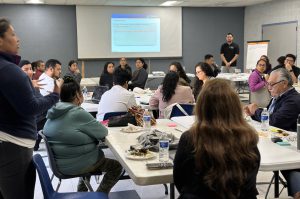
Advancing a Collaborative Agenda in Southeast LA
Advancing a Collaborative Agenda in Southeast LA In 2022, the California Community Foundation (CCF) launched the Regional Recovery Hub to strengthen place-based coordination in Los Angeles County
Variable Definitions:
This dataset presents the Expected Annual Loss in a given area for five different natural hazards compared to all other places across the United States:
Source:
Federal Emergency Management Agency (FEMA)’s National Risk Index
Years Available:
2023
Methodology
The Expected Annual Loss takes into account three factors:
The National Risk Index is a tool for assessing the potential impacts of natural hazards by providing relative Risk Index scores and ratings. These scores are calculated using data on Expected Annual Loss (EAL), which estimates the total dollar value of losses to buildings, agriculture, and people exposed to various natural hazards. The Expected Annual Loss metric offers a comprehensive understanding of the financial risks associated with disasters, enabling policymakers and communities to better prepare for and mitigate potential damages. By evaluating economic vulnerabilities, the National Risk Index serves as a critical resource for disaster preparedness and resilience planning across the US.
Los Angeles County is particularly susceptible to natural disasters, including the significant threat of earthquakes . Because all areas of Los Angeles County are at a high risk for earthquakes compared to most other places in the U.S., the whole county has a high Expected Annual Loss for earthquakes. Climate change exacerbates the frequency and intensity of many types of natural disasters, impacting local areas profoundly. For instance, Dana Point, a beachside community in Southern California, has faced significant challenges due to high surf and heavy rains driven by a hyperactive El Niño season. Recent events saw homes nearly collapsing into the ocean due to coastal landslides, illustrating how global climate trends manifest in local hazards (Surfer, 2023). Shifting the perspective from a global to a local lens is crucial for discussions around climate change, as it highlights specific risks, making the data more actionable for residents and policymakers.
The National Risk Index plays a crucial role in identifying vulnerable regions and improving hazard mitigation plans, prioritizing and allocating resources, and enhancing long-term recovery strategies for high-risk or low-resilience areas. Preparing for and recovering from natural disasters often requires ample resources and infrastructure, which can put a particular strain on low-income communities. These communities are often located in areas more susceptible to hazards and have homes that are less structurally sound to withstand severe weather conditions. Additionally, they may have limited access to emergency services and support networks, making recovery more challenging. Understanding these dynamics is essential for creating equitable disaster response strategies that address the needs of the most vulnerable populations.
Written by Xitong Lu
Citation:
Cutter, S. L., Boruff, B. J., & Shirley, W. L. (2003). Social vulnerability to environmental hazards. Social Science Quarterly, 84(2), 242-261. https://doi.org/10.1111/1540-6237.8402002
Federal Emergency Management Agency (FEMA). (2021). National Risk Index for Natural Hazards. Retrieved from https://www.fema.gov/nri
Surfer. (2023). Dana Point homes nearly collapse into ocean due to high surf and heavy rains. Retrieved from https://www.surfer.com/news/dana-point-homes-nearly-collapse-into-ocean-high-surf-heavy-rains
U.S. Global Change Research Program (USGCRP). (2018). Fourth National Climate Assessment. Volume II: Impacts, Risks, and Adaptation in the United States. https://nca2018.globalchange.gov/

Advancing a Collaborative Agenda in Southeast LA In 2022, the California Community Foundation (CCF) launched the Regional Recovery Hub to strengthen place-based coordination in Los Angeles County

In 2022, the California Community Foundation (CCF) launched the Regional Recovery Hub to strengthen place-based coordination in Los Angeles County regions that were most heavily impacted by
